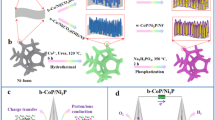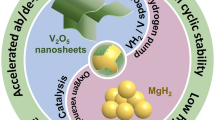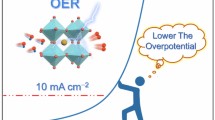Abstract
Industrial production of NH3 from N2 and H2 significantly relies on Haber–Bosch process, which suffers from high energy consume and CO2 emission. As a sustainable and environmentally-benign alternative process, electrochemical artificial N2 fixation at ambient conditions, however, is highly required efficient electrocatalysts. In this study, we demonstrate that hexagonal boron nitride nanosheet (h-BNNS) is able to electrochemically catalyze N2 to NH3. In acidic solution, h-BNNS catalyst attains a high NH3 formation rate of 22.4 μg·h–1·mg–1cat. and a high Faradic efficiency of 4.7% at–0.75 V vs. reversible hydrogen electrode, with excellent stability and durability. Density functional theory calculations reveal that unsaturated boron at the edge site can activate inert N2 molecule and significantly reduce the energy barrier for NH3 formation.

Similar content being viewed by others
References
Smil, V. Detonator of the population explosion. Nature 1999, 400, 415.
Schlögl, R. Catalytic synthesis of ammonia—A “never–ending story”? Angew. Chem., Int. Ed. 2003, 42, 2004–2008.
Rosca, V.; Duca, M.; De Groot, M. T.; Koper, M. T. M. Nitrogen cycle electrocatalysis. Chem. Rev. 2009, 109, 2209–2244.
Vegge, T.; Sørensen, R. Z.; Klerke, A.; Hummelshøj, J. S.; Johannessen, T.; Nørskov, J. K.; Christensen, C. H. Indirect hydrogen storage in metal ammines. In Solid–State Hydrogen Storage. Walker, G., Ed.; Woodhead Publishing Limited: Cambridge, 2008; pp 533–564.
Ling, C. Y.; Niu, X. H.; Li, Q.; Du, A. J.; Wang, J. L. Metal–free single atom catalyst for N2 fixation driven by visible light. J. Am. Chem. Soc. 2018, 140, 14161–14168.
Fryzuk, M. D.; Love, J. B.; Rettig, S. J.; Young, V. G. Transformation of coordinated dinitrogen by reaction with dihydrogen and primary silanes. Science 1997, 275, 1445–1447.
Singh, A. R.; Rohr, B. A.; Schwalbe, J. A.; Cargnello, M.; Chan, K.; Jaramillo, T. F.; Chorkendorff, I.; Nørskov, J. K. Electrochemical ammonia synthesis—The selectivity challenge. ACS Catal. 2017, 7, 706–709.
Jennings, J. R. Catalytic Ammonia Synthesis; Plenum: New York, 1991.
Dybkjaer, I. Ammonia production processes. In Ammonia: Catalysis and Manufacture. Nielsen, A., Ed.; Springer: Berlin, Heidelberg, 1995; pp 199–327.
Chan, M. K.; Kim, J.; Rees, D. C. The nitrogenase FeMo–cofactor and P–cluster pair: 2.2 a resolution structures. Science 1993, 260, 792–794.
Burgess, B. K.; Lowe, D. J. Mechanism of molybdenum nitrogenase. Chem. Rev. 1996, 96, 2983–3011.
Brown, K. A.; Harris, D. F.; Wilker, M. B.; Rasmussen, A.; Khadka, N.; Hamby, H.; Keable, S.; Dukovic, G.; Peters, J. W.; Seefeldt, L. C.; King, P. W. Light–driven dinitrogen reduction catalyzed by a CdS: Nitrogenase MoFe protein biohybrid. Science 2016, 352, 448–450.
Seh, Z. W.; Kibsgaard, J.; Dickens, C. F.; Chorkendorff, I.; Nørskov, J. K.; Jaramillo, T. F. Combining theory and experiment in electrocatalysis: Insights into materials design. Science 2017, 355, eaad4998.
Guo, C. X.; Ran, J. R.; Vasileff, A.; Qiao, S. Z. Rational design of electrocatalysts and photo(electro)catalysts for nitrogen reduction to ammonia (NH3) under ambient conditions. Energy Environ. Sci. 2018, 11, 45–56.
Cao, N.; Zheng, G. F. Aqueous electrocatalytic N2 reduction under ambient conditions. Nano Res. 2018, 11, 2992–3008.
Bao, D.; Zhang, Q.; Meng, F. L.; Zhong, H. X.; Shi, M. M.; Zhang, Y.; Yan, J. M.; Jiang, Q.; Zhang, X. B. Electrochemical reduction of N2 under ambient conditions for artificial N2 fixation and renewable energy storage using N2/NH3 cycle. Adv. Mater. 2017, 29, 1604799.
Nazemi, M.; Panikkanvalappil, S. R.; El–Sayed, M. A. Enhancing the rate of electrochemical nitrogen reduction reaction for ammonia synthesis under ambient conditions using hollow gold nanocages. Nano Energy 2018, 49, 316–323.
Kordali, V.; Kyriacou, G.; Lambrou, C. Electrochemical synthesis of ammonia at atmospheric pressure and low temperature in a solid polymer electrolyte cell. Chem. Commun. 2000, 1673–1674.
Kordali, V.; Kyriacou, G.; Lambrou, C. Electrochemical synthesis of ammonia at atmospheric pressure and low temperature in a solid polymer electrolyte cell. Chem. Commun. 2000, 1673–1674.
Huang, H. H.; Xia, L.; Shi, X. F.; Asiri, A. M.; Sun, X. P. Ag nanosheets for efficient electrocatalytic N2 fixation to NH3 under ambient conditions. Chem. Commun. 2018, 54, 11427–11430.
Chen, S. M.; Perathoner, S.; Ampelli, C.; Mebrahtu, C.; Su, D. S.; Centi, G. Electrocatalytic synthesis of ammonia at room temperature and atmospheric pressure from water and nitrogen on a carbon–nanotube–based electrocatalyst. Angew. Chem., Int. Ed. 2017, 56, 2699–2703.
Chen, S. M.; Perathoner, S.; Ampelli, C.; Mebrahtu, C.; Su, D. S.; Centi, G. Room–temperature electrocatalytic synthesis of NH3 from H2O and N2 in a gas–liquid–solid three–phase reactor. ACS Sustainable Chem. Eng. 2017, 5, 7393–7400.
Yang, D. S.; Chen, T.; Wang, Z. J. Electrochemical reduction of aqueous nitrogen (N2) at a low overpotential on (110)–oriented Mo nanofilm. J. Mater. Chem. A 2017, 5, 18967–18971.
Lv, C.; Yan, C. S.; Chen, G.; Ding, Y.; Sun, J. X.; Zhou, Y. S.; Yu, G. H. An amorphous noble–metal–free electrocatalyst that enables nitrogen fixation under ambient conditions. Angew. Chem., Int. Ed. 2018, 57, 6073–6076.
Liu, Q.; Zhang, X. X.; Zhang, B.; Luo, Y. L.; Cui, G. W.; Xie, F. Y.; Sun, X. P. Ambient N2 fixation to NH3 Electrocatalyzed by a spinel Fe3O4 nanorod. Nanoscale 2018, 10, 14386–14389.
Zhang, R.; Zhang, Y.; Ren, X.; Cui, G. W.; Asiri, A. M.; Zheng, B. Z.; Sun, X. P. High–efficiency electrosynthesis of ammonia with high selectivity under ambient conditions enabled by VN nanosheet array. ACS Sustainable Chem. Eng. 2018, 6, 9545–9549.
Qiu, W. B.; Xie, X. Y.; Qiu, J. D.; Fang, W. H.; Liang, R. P.; Ren, X.; Ji, X. Q.; Cui, G. W.; Asiri, A. M.; Cui, G. L.; Tang, B.; Sun, X. P. High–performance artificial nitrogen fixation at ambient conditions using a metal–free electrocatalyst. Nat. Commun. 2018, 9, 3485.
Han, J. R.; Liu, Z. C.; Ma, Y. J.; Cui, G. W.; Xie, F. Y.; Wang, F. X.; Wu, Y. P.; Gao, S. Y.; Xu, Y. H.; Sun, X. P. Ambient N2 fixation to NH3 at ambient conditions: Using Nb2O5 nanofiber as a high–performance electrocatalyst. Nano Energy 2018, 52, 264–270.
Zhang, Y.; Qiu, W. B.; Ma, Y. J.; Luo, Y. L.; Tian, Z. Q.; Cui, G. W.; Xie, F. Y.; Chen, L.; Li, T. S.; Sun, X. P. High–performance electrohydrogenation of N2 to NH3 catalyzed by multishelled hollow Cr2O3 microspheres under ambient conditions. ACS Catal. 2018, 8, 8540–8544.
Zhang, L.; Ji, X. Q.; Ren, X.; Luo, Y. L.; Shi, X. F.; Asiri, A. M.; Zheng, B. Z.; Sun, X. P. Efficient electrochemical N2 reduction to NH3 on MoN nanosheets array under ambient conditions. ACS Sustainable Chem. Eng. 2018, 6, 9550–9554.
Li, X. H.; Li, T. S.; Ma, Y. J.; Wei, Q.; Qiu, W. B.; Guo, H. R.; Shi, X. F.; Zhang, P.; Asiri, A. M.; Chen, L.; Tang, B.; Sun, X. P. Boosted electrocatalytic N2 reduction to NH3 by defect–rich MoS2 nanoflower. Adv. Energy Mater. 2018, 8, 1801357.
Wang, Z.; Gong, F.; Zhang, L.; Wang, R.; Ji, L.; Liu, Q.; Luo, Y. L.; Guo, H. R.; Li, Y. H.; Gao, P.; Shi, X. F.; Li, B. H.; Tang, B.; Sun, X. P. Electrocatalytic hydrogenation of N2 to NH3 by MnO: Experimental and theoretical investigations. Adv. Sci. 2018, 5, 1801182.
Liu, Y. M.; Su, Y.; Quan, X.; Fan, X. F.; Chen, S.; Yu, H. T.; Zhao, H. M.; Zhang, Y. B.; Zhao, J. J. Facile ammonia synthesis from electrocatalytic N2 reduction under ambient conditions on N–doped porous carbon. ACS Catal. 2018, 8, 1186–1191.
Novoselov, K. S.; Geim, A. K.; Morozov, S. V.; Jiang, D.; Zhang, Y.; Dubonos, S. V.; Grigorieva, I. V.; Firsov, A. A. Electric field effect in atomically thin carbon films. Science 2004, 306, 666–669.
Mirehi, A.; Heidari–Semiromi, E. Effects of the interplay between electronelectron interaction and intrinsic spin–orbit interaction on the indirect RKKY coupling in graphene nanoflakes. Phys. Chem. Chem. Phys. 2019, 21, 1324–1335.
Coleman, J. N.; Lotya, M.; O’Neill, A.; Bergin, S. D.; King, P. J.; Khan, U.; Young, K.; Gaucher, A.; De, S.; Smith, R. J. et al. Two–dimensional nanosheets produced by liquid exfoliation of layered materials. Science 2011, 331, 568–571.
Xu, M. S.; Liang, T.; Shi, M. M.; Chen, H. Z. Graphene–like twodimensional materials. Chem. Rev. 2013, 113, 3766–3798.
Sun, Y. F.; Gao, S.; Lei, F. C.; Xie, Y. Atomically–thin two–dimensional sheets for understanding active sites in catalysis. Chem. Soc. Rev. 2015, 44, 623–636.
Chen, Y.; Tan, C. L.; Zhang, H.; Wang, L. Z. Two–dimensional graphene analogues for biomedical applications. Chem. Soc. Rev. 2015, 44, 2681–2701.
Zhang, Z. H.; Penev, E. S.; Yakobson, B. I. Two–dimensional boron: Structures, properties and applications. Chem. Soc. Rev. 2017, 46, 6746–6763.
Kong, X. K.; Liu, Q. C.; Zhang, C. L.; Peng, Z. M.; Chen, Q. W. Elemental two–dimensional nanosheets beyond graphene. Chem. Soc. Rev. 2017, 46, 2127–2157.
Zhang, K. L.; Feng, Y. L.; Wang, F.; Yang, Z. C.; Wang, J. Two dimensional hexagonal boron nitride (2D–hBN): Synthesis, properties and applications. J. Mater. Chem. C 2017, 5, 11992–12022.
Golberg, D.; Bando, Y.; Huang, Y.; Terao, T.; Mitome, M.; Tang, C. C.; Zhi, C. Y. Boron nitride nanotubes and nanosheets. ACS Nano 2010, 4, 2979–2993.
Zeng, H. B.; Zhi, C. Y.; Zhang, Z. H.; Wei, X. L.; Wang, X. B.; Guo, W. L.; Bando, Y.; Golberg, D. “White graphenes”: Boron nitride nanoribbons via boron nitride nanotube unwrapping. Nano Lett. 2010, 10, 5049–5055.
Zobelli, A.; Gloter, A.; Ewels, C. P.; Seifert, G.; Colliex, C. Electron knock–on cross section of carbon and boron nitride nanotubes. Phys. Rev. B 2007, 75, 245402.
Zhang, Z. H.; Guo, W. L. Energy–gap modulation of BN ribbons by transverse electric fields: First–principles calculations. Phys. Rev. B 2008, 77, 075403.
Barone, V.; Peralta, J. E. Magnetic boron nitride nanoribbons with tunable electronic properties. Nano Lett. 2008, 8, 2210–2214.
Britnell, L.; Gorbachev, R. V.; Jalil, R.; Belle, B. D.; Schedin, F.; Katsnelson, M. I.; Eaves, L.; Morozov, S. V.; Mayorov, A. S.; Peres, N. M. R. et al. Electron tunneling through ultrathin boron nitride crystalline barriers. Nano Lett. 2012, 12, 1707–1710.
Wang, Z. F.; Tang, Z. J.; Xue, Q.; Huang, Y.; Huang, Y.; Zhu, M. S.; Pei, Z. X.; Li, H. F.; Jiang, H. B.; Fu, C. X.; Zhi, C. Y. Fabrication of boron nitride nanosheets by exfoliation. Chem. Rec. 2016, 16, 1204–1215.
Bao, J.; Jeppson, K.; Edwards, M.; Fu, Y. F.; Ye, L. L.; Lu, X. Z.; Liu, J. Synthesis and applications of two–dimensional hexagonal boron nitride in electronics manufacturing. Electron. Mater. Lett. 2016, 12, 1–16.
Kibsgaard, J.; Tsai, C.; Chan, K.; Benck, J. D.; Nørskov, J. K.; Abild–Pedersen, F.; Jaramillo, T. F. Designing an improved transition metal phosphide catalyst for hydrogen evolution using experimental and theoretical trends. Energy Environ. Sci. 2015, 8, 3022–3029.
Grahame, D. C. The electrical double layer and the theory of electrocapillarity. Chem. Rev. 1947, 41, 441–501.
Kötz, R.; Carlen, M. Principles and applications of electrochemical capacitors. Electrochim. Acta 2000, 45, 2483–2498.
Zhu, D.; Zhang, L. H.; Ruther, R. E.; Hamers, R. J. Photo–illuminated diamond as a solid–state source of solvated electrons in water for nitrogen reduction. Nat. Mater. 2013, 12, 836–841.
Watt, G. W.; Chrisp, J. D. Spectrophotometric method for determination of hydrazine. Anal. Chem. 1952, 24, 2006–2008.
Segall, M. D.; Lindan, P. J. D.; Probert, M. J.; Pickard, C. J.; Hasnip, P. J.; Clark, S. J.; Payne, M. C. First–principles simulation: Ideas, illustrations and the castep code. J. Phys.: Condens. Matter 2002, 14, 2717–2744.
Perdew, J. P.; Chevary, J. A.; Vosko, S. H.; Jackson, K. A.; Pederson, M. R.; Singh, D. J.; Fiolhais, C. Atoms, molecules, solids, and surfaces: Applications of the generalized gradient approximation for exchange and correlation. Phys. Rev. B 1992, 46, 6671–6687.
Blöchl, P. E. Projector augmented–wave method. Phys. Rev. B 1994, 50, 17953–17979.
Grimme, S.; Antony, J.; Ehrlich, S.; Krieg, H. A consistent and accurate ab initio parametrization of density functional dispersion correction (DFT–D) for the 94 elements H–Pu. J. Chem. Phys. 2010, 132, 154104.
Thangasamy, P.; Sathish, M. Supercritical fluid processing: A rapid, one–pot exfoliation process for the production of surfactant–free hexagonal boron nitride nanosheets. CrystEngComm 2015, 17, 5895–5899.
Sun, W. L.; Meng, Y.; Fu, Q. R.; Wang, F.; Wang, G. J.; Gao, W. H.; Huang, X. C.; Lu, F. S. High–yield production of boron nitride nanosheets and its uses as a catalyst support for hydrogenation of nitroaromatics. ACS Appl. Mater. Interfaces 2016, 8, 9881–9888.
Zhong, B.; Wu, Y.; Huang, X. X.; Wen, G. W.; Yu, H. M.; Zhang, T. Hollow BN microspheres constructed by nanoplates: Synthesis, growth mechanism and cathodoluminescence property. CrystEngComm 2011, 13, 819–826.
Xu, Z. G.; Tian, H.; Khanaki, A.; Zheng, R. J.; Suja, M.; Liu, J. L. Largearea growth of multi–layer hexagonal boron nitride on polished cobalt foils by plasma–assisted molecular beam epitaxy. Sci. Rep. 2017, 7, 43100.
Légaré, M. A.; Bélanger–Chabot, G.; Dewhurst, R. D.; Welz, E.; Krummenacher, I.; Engels, B.; Braunschweig, H. Nitrogen fixation and reduction at boron. Science 2018, 359, 896–900.
Zhou, F. L.; Azofra, L. M.; Ali, M.; Kar, M.; Simonov, A. N.; McDonnell–Worth, C.; Sun, C. H.; Zhang, X. Y.; MacFarlane, D. R. Electro–synthesis of ammonia from nitrogen at ambient temperature and pressure in ionic liquids. Energy Environ. Sci. 2017, 10, 2516–2520.
Xia, L.; Wu, X. F.; Wang, Y.; Niu, Z. G.; Liu, Q.; Li, T. S.; Shi, X. F.; Asiri, A. M.; Sun, X. P. S–doped carbon nanospheres: An efficient electrocatalyst toward artificial N2 fixation to NH3. Small Methods 2018, 2, 1800251.
Kong, J. M.; Lim, A.; Yoon, C.; Jang, J. H.; Ham, H. C.; Han, J.; Nam, S.; Kim, D.; Sung, Y. E.; Choi, J.; Park, H. S. Electrochemical synthesis of NH3 at low temperature and atmospheric pressure using a γ–Fe2O3 catalyst. ACS Sustainable Chem. Eng. 2017, 5, 10986–10995.
Ren, X; Zhao, J. X.; Wei, Q.; Ma, Y. J.; Guo, H. R.; Liu, Q.; Wang, Y.; Cui, G. W.; Asiri, A. M.; Li, B. H.; Tang, B.; Sun, X. P. High–performance N2–to–NH3 conversion electrocatalyzed by Mo2C nanorod. ACS Cent. Sci. 2019, 5, 116–121.
Guo, C. X.; Zhang, L. Y.; Miao, J. W.; Zhang, J. T.; Li, C. M. DNAfunctionalized graphene to guide growth of highly active Pd nanocrystals as efficient electrocatalyst for direct formic acid fuel cells. Adv. Energy Mater. 2013, 3, 167–171.
Skúlason, E.; Bligaard, T.; Gudmundsdóttir, S.; Studt, F.; Rossmeisl, J.; Abild–Pedersen, F.; Vegge, T.; Jónssonac, H.; Nørskov, J. K. A theoretical evaluation of possible transition metal electro–catalysts for N2 reduction. Phys. Chem. Chem. Phys. 2012, 14, 1235–1245.
Zhao, J. X.; Chen, Z. F. Single Mo atom supported on defective boron nitride monolayer as an efficient electrocatalyst for nitrogen fixation: A computational study. J. Am. Chem. Soc. 2017, 139, 12480–12487.
Acknowledgements
This work was supported by the National Natural Science Foundation of China (Nos. 21575137, 21775089, and 21375076), the Key Research and Development Program of Shandong Province (No. 2015GSF121031) and the Natural Science Foundation Projects of Shandong Province (Nos. ZR2017JL010, ZR2017QB008, and ZR2017LEE006).
Author information
Authors and Affiliations
Corresponding authors
Electronic supplementary material
Rights and permissions
About this article
Cite this article
Zhang, Y., Du, H., Ma, Y. et al. Hexagonal boron nitride nanosheet for effective ambient N2 fixation to NH3. Nano Res. 12, 919–924 (2019). https://doi.org/10.1007/s12274-019-2323-x
Received:
Revised:
Accepted:
Published:
Issue Date:
DOI: https://doi.org/10.1007/s12274-019-2323-x




